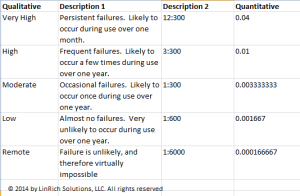
Whenever we facilitate or participate in an FMEA or a project risk assessment on behalf of our clients, we encourage discussion about the probability scale being used. Teams have difficulty reconciling their qualitative and quantitative estimates. For instance, if a team thinks a risk is “Highly Probable”, that’s a qualitative estimate that folks can likely agree on. But ask the team to quantify “Highly Probable” and you’re going to get a wide range of answers. Does “Highly Probable” mean 1 in 2? Or is it 1 in 1,000? Is it higher? Is it lower?
Dr. Richard Feynman, the renowned Noble Prize winning physicist, was on the presidential commission charged with determining the root cause of the space shuttle Challenger disaster in 1986. In his excellent book titled “What Do You Care What Other People Think?” he describes in fascinating detail how he navigated his way through NASA to uncover facts related to the disaster. During his investigation, he discovered a wide range of opinions regarding the probability of a cataclysmic shuttle failure. Senior management at NASA believed that the probability of failure was 1 in 100,000. Some of the rocket engine engineers believed the probability to be 1 in 300 and one of the range safety officers determined it to be 1 in 100. Who was right?
To have a meaningful FMEA or risk assessment, the probability scales should be customized to the situation. The trick is to put clarifying “gut checks” to the team in terms that can be understood in the real world. For instance, Dr. Feynman, upon hearing NASA management’s number of 1 in 100,000 wrote “That means you could fly the shuttle every day for an average of 300 years between accidents—every day, one flight, for 300 years—which is obviously crazy!”
© 2014 by LinRich Solutions, LLC. All rights reserved


